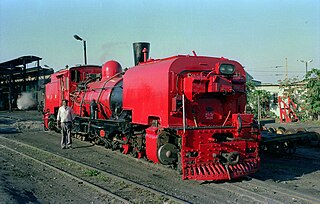
A vacuum pump is a device that draws gas molecules from a sealed volume in order to leave behind a partial vacuum. The job of a vacuum pump is to generate a relative vacuum within a capacity. The first vacuum pump was invented in 1650 by Otto von Guericke, and was preceded by the suction pump, which dates to antiquity.

The vacuum brake is a braking system employed on trains and introduced in the mid-1860s. A variant, the automatic vacuum brake system, became almost universal in British train equipment and in countries influenced by British practice. Vacuum brakes also enjoyed a brief period of adoption in the United States, primarily on narrow-gauge railroads. Their limitations caused them to be progressively superseded by compressed air systems starting in the United Kingdom from the 1970s onward. The vacuum brake system is now obsolete; it is not in large-scale usage anywhere in the world, other than in South Africa, largely supplanted by air brakes.
A vacuum ejector, or simply ejector is a type of vacuum pump, which produces vacuum by means of the Venturi effect.

An injector is a system of ducting and nozzles used to direct the flow of a high-pressure fluid in such a way that a lower pressure fluid is entrained in the jet and carried through a duct to a region of higher pressure. It is a fluid-dynamic pump with no moving parts, excepting a valve to control inlet flow. A steam injector is a typical application of the principle used to deliver cold water to a boiler against its own pressure, using its own live or exhaust steam, replacing any mechanical pump. When first developed, its operation was intriguing because it seemed paradoxical, almost like perpetual motion, but it was later explained using thermodynamics. Other types of injector may use other pressurised motive fluids such as air.
Manifold vacuum, or engine vacuum in an internal combustion engine is the difference in air pressure between the engine's intake manifold and Earth's atmosphere.

A surface condenser is a commonly used term for a water-cooled shell and tube heat exchanger installed to condense exhaust steam from a steam turbine in thermal power stations. These condensers are heat exchangers which convert steam from its gaseous to its liquid state at a pressure below atmospheric pressure. Where cooling water is in short supply, an air-cooled condenser is often used. An air-cooled condenser is however, significantly more expensive and cannot achieve as low a steam turbine exhaust pressure as a water-cooled surface condenser.

A condensing steam locomotive is a type of locomotive designed to recover exhaust steam, either in order to improve range between taking on boiler water, or to reduce emission of steam inside enclosed spaces. The apparatus takes the exhaust steam that would normally be used to produce a draft for the firebox, and routes it through a heat exchanger, into the boiler water tanks. Installations vary depending on the purpose, design and the type of locomotive to which it is fitted. It differs from the usual closed cycle condensing steam engine, in that the function of the condenser is primarily either to recover water, or to avoid excessive emissions to the atmosphere, rather than maintaining a vacuum to improve both efficiency and power.

The Lempor ejector is a steam locomotive exhaust system developed by noted Argentine locomotive engineer Livio Dante Porta. The ejector's name is a portmanteau of the names of Porta and Belgian locomotive engineer Maurice Lemaître.
Secondary air injection is a vehicle emissions control strategy introduced in 1966, wherein fresh air is injected into the exhaust stream to allow for a fuller secondary combustion of exhaust gases.
A throttle is the mechanism by which fluid flow is managed by constriction or obstruction.
Steam jet cooling uses a high-pressure jet of steam to cool water or other fluid media. Typical uses include industrial sites, where a suitable steam supply already exists for other purposes or, historically, for air conditioning on passenger trains which use steam for heating. Steam jet cooling experienced a wave of popularity during the early 1930s for air conditioning large buildings. Steam ejector refrigeration cycles were later supplanted by systems using mechanical compressors.

A venturi scrubber is designed to effectively use the energy from a high-velocity inlet gas stream to atomize the liquid being used to scrub the gas stream. This type of technology is a part of the group of air pollution controls collectively referred to as wet scrubbers.
An injector, or steam injector, a pump-like device without moving parts.

A snifting valve is an automatic anti-vacuum valve used in a steam locomotive when coasting. The word Snift imitates the sound made by the valve.
Ejection or Eject may refer to:
The counter-pressure brake, also named the Riggenbach counter-pressure brake after its inventor, Niklaus Riggenbach, is a dynamic railway brake on steam locomotives that brakes the locomotive using the driving cylinders. In doing so it reduces wear and tear and overheating of the driving wheel tyres and brake blocks and enables a continuously high brake force to be applied. The brake works by using the cylinders as air compressors and converting kinetic energy into heat. Steam is emitted during braking but this does not come from the boiler, it is produced by evaporation of water used to cool the cylinders.

Davies and Metcalfe Ltd was a railway equipment and locomotive manufacturer from Romiley, Manchester, England. It was founded in Aberystwyth in 1878. The company is now part of Sabwabco Davies & Metcalfe Ltd of Leek, Staffordshire.

The Alfred County Railway Class NG G16A 2-6-2+2-6-2 of 1989 was a steam locomotive from the South African Railways era.

The Natal Government Railways Class K 2-6-0T of 1877 was a South African steam locomotive from the pre-Union era in the Natal Colony.
This page is based on this
Wikipedia article Text is available under the
CC BY-SA 4.0 license; additional terms may apply.
Images, videos and audio are available under their respective licenses.










